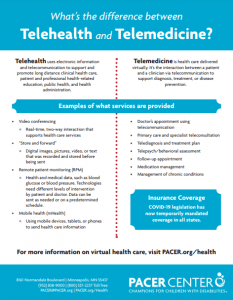About Telehealth and Telemedicine
National Consortium Of Telehealth Resource Centers
Tools
Planning for a Successful Telehealth Visit
Articles
Just in… Telehealth Tips From Family Organizations (Spanish version available here)
Technology Provides Options for Medical Care from a Distance
Telebehavioral Health: An Effective Alternative to In-Person Care
The Three Ps – Plan, Prepare, Participate – of Telehealth
Tips You May Not Know to Improve Telehealth for Patients and Providers
Videos


